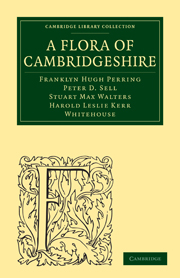Book contents
EXPLANATION OF TEXT
Published online by Cambridge University Press: 03 May 2011
Summary
With few exceptions the system and nomenclature in the following account follows that of J. E. Dandy (1958) for the Vascular Plants, P. W. Richards and E. C. Wallace (1950) for the Mosses, and E. W. Jones (1958) for the Liverworts. Following the scientific name, a well-known vernacular one may be given. If there is a well-known name for a number of species all in one genus (e.g. Willow-herb for Epilobium species) it is placed in parentheses after the generic name. Following the specific vernacular name is the first known record for the plant in the county. This may be based on either a published record, a field record or a herbarium specimen. On the next line follows a list of synonyms that are used by Babington (1860), Evans (1939) or Clapham, Tutin & Warburg (1952). Old binomials and pre-Linnaean names by the earlier authors are given in Babington (1860). An account of the habitat of the species is then given with any notes on rare, difficult or interesting species.
The distribution is indicated by listing the Ordnance Survey Grid Reference numbers given on the Map. Note that most of the 10 km. squares are in 100 km. square 52; but a few squares in the north of the county belong to 100 km. square 53, and these are given at the end of the main (52) series. Numbers in square brackets are given in a separate series.
- Type
- Chapter
- Information
- A Flora of Cambridgeshire , pp. 31 - 32Publisher: Cambridge University PressPrint publication year: 2009First published in: 1964



